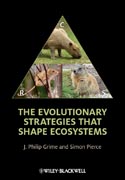
In 1837 a young Charles Darwin took his notebook, wrote "I think" and then sketched a rudimentary, stick-like tree. Each branch of Darwin's tree of life told a story of survival and adaptation - adaptation of animals and plants not just to the environment but also to life with other living things. However, more than 150 years since Darwin published his singular idea of natural selection, the science of ecology has yet to account for how contrasting evolutionary outcomes affect the ability of organisms to coexist in communities and to regulate ecosystem functioning.In this book Philip Grime and Simon Pierce explain how evidence from across the world is revealing that, beneath the wealth of apparently limitless and bewildering variation in detailed structure and functioning, the essential biology of all organisms is subject to the same set of basic interacting constraints on life-history and physiology. The inescapable resulting predicament during the evolution of every species is that, according to habitat, each must adopt a predictable compromise with regard to how they use the resources at their disposal in order to survive. The compromise involves the investment of resources in either the effort to acquire more resources, thetolerance of factors that reduce metabolic performance, or reproduction. Thisthree-way trade-off is the irreducible core of the universal adaptive strategy theory which Grime and Pierce use to investigate how two environmental filters selecting, respectively, for convergence and divergence in organism function determine the identity of organisms in communities, and ultimately how different evolutionary strategies affect the functioning of ecosystems. This book reflects an historic phase in which evolutionary processes are finally moving centre stage in the effort to unify ecological theory, and animal, plant and microbial ecology have begun to find a common theoretical framework.Visit www.wiley.com/go/grime/evolutionarystrategies to access the artwork from the book. INDICE: Preface xChapter Summaries xiiAcknowledgements xviiiIntroduction 11 Evolution and Ecology: a Janus Perspective? 3Evolutionary biology 3Ecology 4The emergence of a science of adaptive strategies 6Summary 72 Primary Strategies: the Ideas 8MacArthur's 'blurred vision' 9The mechanism of convergence; trade-offs 10The theory of r- and K-selection 11CSR Theory 12Summary 233 Primary Adaptive Strategies in Plants 25The search for adaptive strategies 26Theoretical work 26Measuring variation in plant traits: screening programmes 28Screening of plant growth rates 29The Integrated Screening Programme 29Further trait screening 34The application of CSR theory 34Virtual plant strategies 36Summary 384 Primary Adaptive Strategies in Organisms Other Than Plants 40The architecture of the tree of life 41r, K and beyond K 42Empirical evidence for three primary strategies in animals 43The universal three-way trade-off 44Mammalia (mammals) 46Aves (avian therapods) 53Squamata (snakes and lizards) (with notes on other extant reptile clades) 56Amphibia (amphibians) 60Osteichthyes (bony fi shes) 61Chondrichthyes (cartilaginous fi shes) 65Insecta (insects) 68Aracnida (spiders, scorpions, mites and ticks) 72Crustacea (crustaceans) 74Echinodermata(sea urchins, starfi sh, crinoids, sea cucumbers) 75Mollusca (snails, clams, squids) 77Annelida (segmented worms) 79Cnidaria (corals, sea anemones, jellyfish, hydras, sea pens) 81Eumycota (fungi) (including notes on lichens) 83Archaea 84Proteobacteria 86Firmicutes 87Cyanobacteria 88Viruses 90Extinct groups 94Universal adaptive strategy theory - the evolution of CSR and beyond K theories 99First steps towards a universal methodology 100Summary 1035 From Adaptive Strategies to Communities 105Plant communities 106Productive disturbed communities 107Productive undisturbed communities 108Unproductive relatively undisturbed communities 111Plant community composition 111The humped-back model 114Origins 114Formulation 115Independent confi rmation and compatibility with new research 116Species-pools, fi lters and community composition 121Evidence for the action of twin fi lters 128Additional mechanisms promoting diversity 132Genetic diversity, intraspecifi c functional diversity and species diversity 132Microbial communities 136The effects of plant strategies on soil microbial communities 139Facilitation in bacterial communities 141Coexistence in marine surface waters 142Novel techniques for investigating microbial adaptive strategies 142Animal communities 144Primary producers delimit animal diversity/productivity relationships 145Twin fi lters and animal community assembly 150Adaptive radiation and community assembly 154Summary 1606 From Strategies to Ecosystems 163Back to Bayreuth 164The Darwinian basis of ecosystem assembly 167How do primary adaptive strategies drive ecosystem functioning? 168The plant traits that drive ecosystems 169The propagation of trait infl uences through food chains 176Complicating factors 178Ecosystem processes 180Dominance and mass ratio effects 180Fluxes and feedbacks between communities 181Top-down control by herbivores 187Top-down control by carnivores 189The key role of eco-evolutionary dynamics 190Summary 1927 The Path from Evolution to Ecology 194What has been learned? 194What are the implications for conservation and management? 198Research priorities for the next decade 199References 202Organism Index 235Subject Index 241
- ISBN: 978-0-470-67482-6
- Editorial: John Wiley & Sons
- Encuadernacion: Rústica
- Páginas: 264
- Fecha Publicación: 20/04/2012
- Nº Volúmenes: 1
- Idioma: Inglés
